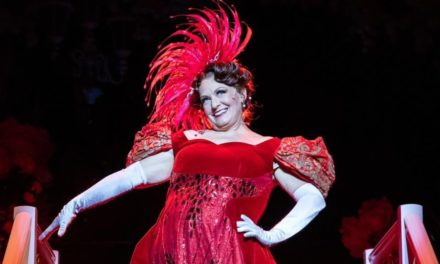SALT LAKE CITY — Arthur Miller is arguably the greatest American playwright of the 20th century, and after viewing his masterpiece The Crucible, it is easy to see why. Linguistically brilliant, with dialogue and monologues to make actors’ hearts skip beats, the show is also impeccably structured with the Salem witch trials playing out like the suspenseful courtroom drama it most certainly was at the time. Miller has an uncanny ability to show “a mirror unto nature,” reaching deep into the psyche of men and women to reveal the rawness of the human heart on stage. Charles Morey, director of Pioneer Theatre Company’s stellar production of The Crucible, pays homage to Miller’s study of the human condition and leads an incredibly dynamic cast into an emotional journey towards self-knowledge. Supplemented by top-notch design elements, this could possibly be the best theatrical production Utah audiences may see this year if they are willing to overlook select flaws.
In the director’s notes, Morey touches on the various ways that Miller’s The Crucible is celebrated in American drama. In addition to his focus on main character John Proctor’s inward examination, he notes that in his play Miller was able to touch on many possible factors that contributed to the historical witch trials of 1692 in Salem Massachusetts. From greed and power to religious hysteria, there is no definitive answer as to why so many innocent people were led to loss of life, but Miller’s account in the play becomes entirely plausible as each character walks the stage. The hysteria and subsequent witchcraft accusations launch the town of Salem into a frenzy, despite the calm sense of upright citizens.

L-R: Fletcher McTaggart (John Proctor) and Claire Brownell (Elizabeth Proctor). Photo by Alexander Weisman.
Any production of The Crucible is only as good as the actor who plays John Proctor, and Fletcher McTaggart delivers. From the over-confident man of the land to the vulnerable prisoner of self, McTaggart’s controlled evolution of character is almost breath-taking, and he handles Miller’s weighty language seemingly effortlessly. He is joined in his impressive performance by Claire Brownell who encapsulates Elizabeth proctor in a simultaneously sorrowful and stoic performance, befitting her character of a wife both scorned by adultery and revered for her goodness, and by Betsy Hogg as Mary Warren, whose performance as one of the afflicted girls surpasses the others in its ability to convey the confusion, fear, loyalty, and hysteria that may well have possessed those in the real Salem. Other stand-out performances include John Michalski as Giles Corey and Anne Cullimore Decker as Rebecca Nurse.

L-R, standing: J. Todd Adams (Reverend John Hale) and Fletcher McTaggart (John Proctor). L-R, kneeling: Stephanie Weeks (Tituba) and Madison Micucci (Abigail Williams). Photo by Alexander Weisman.
Highlighting the high-energy performances on stage was the deliberately stagnant scene design by Gary English and its included symbolism that contrasted nicely to the dramatic realism of the play. Flanking either end of the stage were a series of long poles with bark still attached, representing dead or dormant trees with no leaves or other signs of life and without the natural bends and crooks of branches that might sway in the breeze. Like their Puritan neighbors, the trees were rigid and cold. The trees also served the purpose of highlighting the isolation of Salem at this time and the very real sense of the wilderness and wild-ness surrounding it. In contrast to the thin trees were the great wide beams that stood to frame in the buildings in which the scenes took place, beams which angled so that the space between them was narrower at the top than at the bottom, creating a claustrophobic affect as if the beams would topple in on themselves and the characters below. So, too, these angled beams seemed as if they could be creating a kind of steeple pointing toward heaven, were it not for the fact that they abruptly stopped far before eyes would lift toward the sky. In all, the dark stage images were powerful and enhancing. So, too, the costume design by Carol Wells-Day, was appropriate and illustrative, giving a sense of both realism and character with the exception of two flaws. The first is the representation of Elizabeth Proctor’s pregnancy in the final scene (she is supposed to be three months along, but was represented well into her third trimester, a gaffe that would distract any mother in the audience). The second is Abigail William’s revealing dress. Unlike the other female characters who maintain prudish Puritan standards of high neck-lines, Abigail’s dress is low-cut revealing what must have been an incredible amount of cleavage for Salem in 1692.
The representation of Abigail (played by Madison Micucci) is, in fact, the most unfortunate troublesome aspect of this production. She is markedly set apart from the other characters with her low-cut dress and highly made-up face. She looks so much the whore of the play that Proctor’s confession of lechery with her should come as no surprise to the ministers and townspeople that act shocked to hear it. In addition, Mirucci’s performance is much too much the villain. In a melodrama or an American Musical her enhanced representation of envy and lust would be a welcome addition, but it has no place in Miller’s realism. One of the first lessons actors learn about “naturalistic” drama is that every character has a motivation and believes in their cause, however misguided. So-played Abigail’s character is far more complex and brings entirely more intrigue to her relationship with John, to the other girls, and to those sitting judgment. One has to assume that the real Salem officials truly believed that witchcraft was among them, an in this production it is difficult to believe that they could not see past Abigail’s obvious pretense. Moreover, her representation is problematic because it creates far too much a sense of the femme fatal that mars the production. If the play is really about John Proctor’s journey from sinful self-confidence to an enlightened sense of self-awareness, there cannot be so much focus on Abigail’s own villainy and vengefulness. No doubt this representation was a directing decision, and possibly one that others might find appropriate. To me, however, it is a distraction from an otherwise impressive production, one that I felt privilege to attend and that made my heart swell for Arthur Miller, in particular, and American theatre, in general. I give it my enthusiastic endorsement.








